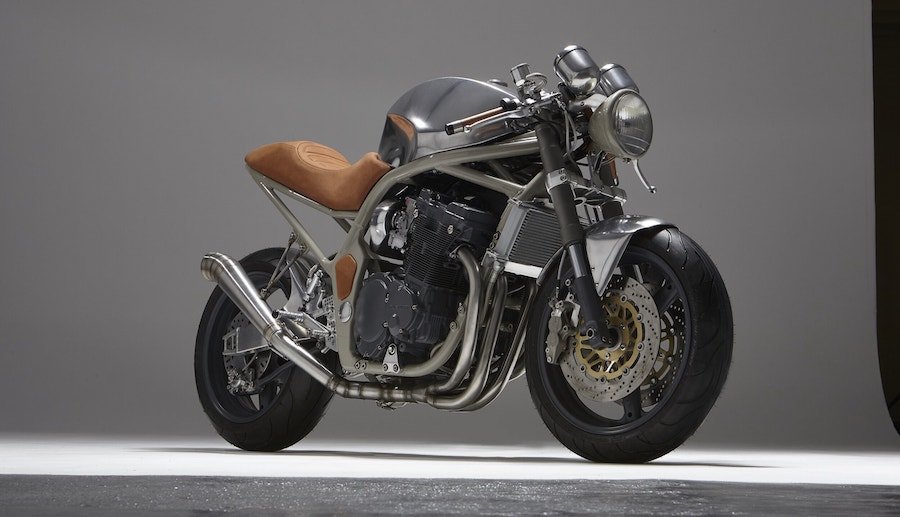Suzuki GSF1200 Sanzoku Has Some of the Best Custom Metalwork You Will Ever See

As you can imagine, these skills come in rather handy when it comes to motorcycle customization, which is part of what Alex deals with nowadays.
He operates as Moto Milo in London, though this is only a side hustle as opposed to a full-time endeavor. Thus, his custom projects are few and far between, but every single one of them is absolutely superb in one way or another. The man’s great eye for detail and practical know-how in metalwork are evident on such builds, always making the end result look like a million bucks.
Nicknamed Sanzoku, the breathtaking cafe racer pictured above is based on a Suzuki GSF1200 Bandit from the model-year 1998. Despite the donor’s outdated looks, it’s still a very solid basis for customization from a mechanical standpoint. Its 1,157cc inline-four engine is capable of producing just under 100 ponies at the crank, which ultimately translates into speeds of up to 140 mph (225 kph) on a good day.
Our protagonist bought the ‘98-model Bandit from a friend of a friend, and the bike had already been subjected to a myriad of custom mods by that point. Very few of these previous additions would be kept during the overhaul, though, as Alex had his own idea of what the GSF was going to become. The conversion took approximately five months from start to finish, and it got underway with a complete teardown.
Then, the project’s author turned his attention to the handling department, first addressing the motorcycle’s outdated suspension. At the front end, he swapped the conventional OEM forks with the upside-down units of a 1999 Ducati 900SS. The same Italian machine was kind enough to also donate its triple clamps, and the rear suspension has been upgraded to match the new forks.
It now makes use of a high-grade Nitron NTR R1 shock absorber, which is a huge improvement over the Bandit’s stock paraphernalia. Aiming to further enhance the motorcycle’s handling characteristics, Alex swapped its front brake calipers with premium Brembo modules. These were mated to the original GSF1200 rotors with the help of custom CNC-machined mounts, and they’re operated by a Nissin master cylinder via Goodridge hoses.
Rizoma supplied the brake fluid reservoirs front and back, while the componentry used for the clutch is once again a mixture of Goodridge and Nissin. The factory three-spoke wheels are still in play, with grippy Michelin rubber embracing their rims. Confident that Sanzoku will handle like a charm, Alex moved on to the other aspects of this conversion. These involved a ton of intricate fabrication work with both steel and aluminum called into action.
The first thing to catch our attention is that mouth-watering fuel tank, which was meticulously built from scratch using aluminum. Its lines are nothing short of majestic, and they’ve beautifully complemented by the sizeable brown leather saddle seen further back. This curvy seat is perched on a bespoke loop-style subframe, whose underside is encased in an alloy plate to keep things looking ultra-clean.
Sporty handmade fenders are present at both ends, with the rear item being a swingarm-mounted part closely flanking the tire. There are many other smaller alloy bits worth mentioning here, including a two-piece airbox, twin gauge housings, and a fresh chain guard, among others. Up in the cockpit area, we find clip-on handlebars kitted with an assortment of high-grade aftermarket items, some of which we’ve mentioned already.
Others include Messner Moto switches, an XM2 quick-action throttle from Domino, and leather grips matching the saddle upholstery. The speedo and tachometer are both stock equipment, only the encasements around them having changed. All the electronics were revamped and stashed away in a tailor-made box beneath the fuel tank, together with a modern battery. The ergonomic package is finished off with a pair of SES rearsets.
Moving on to the powertrain sector, the only major mods had to do with the intake and exhaust. The former employs Mikuni RS36 carburetors along with the custom airbox we’ve mentioned earlier, while the latter is yet another masterclass in metal fabrication. This time using stainless-steel, the bike-modding connoisseur at Moto Milo came up with a stunning four-one-two setup we can’t get enough of.
Brushed alloy is the chosen finish on the bodywork components, but the wheels and engine got wrapped in a layer of black powder coating. On the other hand, the frame was painted in a faded greenish hue, while the upper fork legs and front brake calipers have been covered in Cerakote. With all these final touches out of the way, Sanzoku was pieced together one last time and sold to an enthusiastic customer soon after.

Nouvelles connexes


